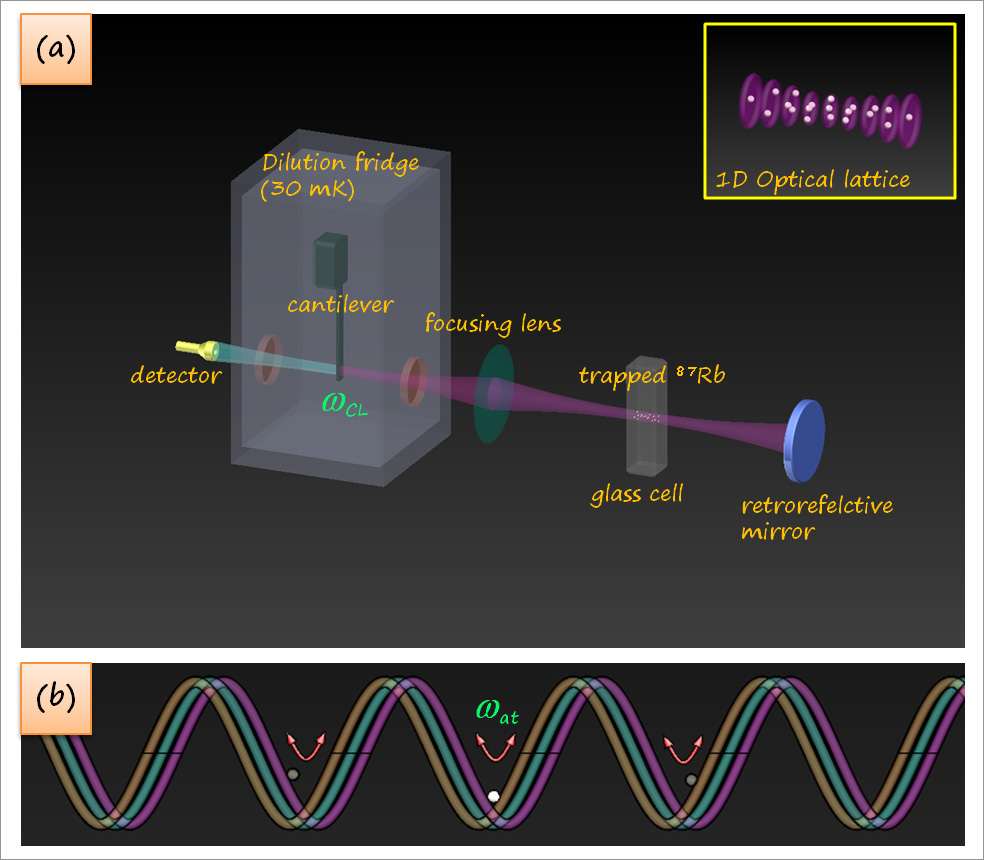Hybrid Quantum Optomechanics
Nano-mechanical-oscillator coupled by Bose Einstein Condensates
This project is a cross disciplinary study combining Atomic Force Microscopy (AFM) and Quantum Optics (QO). It is a cooperating project within institutes in Universität Hamburg. Our expertise is AFM as well as its application in ultrahigh vacuum (UHV) and cryogenic environments. The QO part, i.e., producing and manipulating ultra cold atom clouds (such as BECs) are done in cooperation with Prof. K. Sengstock's group. Our final goal is to build up a hybrid quantum mechanical setup, which can be used to study the coupling between a quantum optical system, i.e., ultracold atoms (a Bose Einstein Condensate; BEC) and a solid state device, i.e., a flexible cantilever which is normally used to carry the tip in AFM.
The scope of this study is to study the (in-)direct coupling between a nanoscale mechanical resonator and the ensemble of atoms in a Bose-Einstein condensate (BEC). Our current working direction is trying to achieve the 'long-distance' ex situ coupling between a kHz mechanical oscillator (such as be a typical silicon AFM cantilever, a SiN membrane, or even some well-known nanostructures, such as a carbon nanotube or a graphene nanodrum, etc.) and one dimensional (1D) optical lattice.

Figure 1. (a) The kHz mechanical oscillator i.e. an AFM cantilever (CL) can be firstly precooled by the cold finger of the dilution refrigerator at around 30 mK in order to bring down the phonon number to a few thousands. The successive cooling of cantilever mode can then be achieved by coupling the cantilever with a natural flexural frequency of  , to a 1 D optical lattice inside a glass cell where cold atoms are trapped inside with a harmonic trapping frequency of
, to a 1 D optical lattice inside a glass cell where cold atoms are trapped inside with a harmonic trapping frequency of  due to the optical dipole force (insert: pancake microtraps for 1D optical lattice, tight trapping along symmetrical axis). The two mechanical systems are mediated by the standing wave from a cooling laser beam (purple) formed between one movable ending 'mirror' of the CL and the other fixed retroreflective ending mirror. When
due to the optical dipole force (insert: pancake microtraps for 1D optical lattice, tight trapping along symmetrical axis). The two mechanical systems are mediated by the standing wave from a cooling laser beam (purple) formed between one movable ending 'mirror' of the CL and the other fixed retroreflective ending mirror. When  , the sympathetical cooling of the cantilever can be achieved by removing energy from the trapped atoms in the lattice in this strongly coupled hybrid quantum system. The damped motion of the CL can be detected using a second laser beam (light blue) through a high sensitive low noise detector (b) The standing wave (green) of light field is modulated back (brown) and forth (purple) due to the movement of the flexible cantilever, generating a harmonic potential sensed by the trapped atoms. The back action of the dipole force to the light field could inversely redistribute the photons in the reflected lattice beams and produce a phase lag to the radiation pressure used to damp out the motion of the cantilever.
, the sympathetical cooling of the cantilever can be achieved by removing energy from the trapped atoms in the lattice in this strongly coupled hybrid quantum system. The damped motion of the CL can be detected using a second laser beam (light blue) through a high sensitive low noise detector (b) The standing wave (green) of light field is modulated back (brown) and forth (purple) due to the movement of the flexible cantilever, generating a harmonic potential sensed by the trapped atoms. The back action of the dipole force to the light field could inversely redistribute the photons in the reflected lattice beams and produce a phase lag to the radiation pressure used to damp out the motion of the cantilever.
